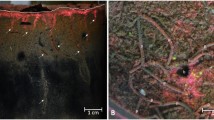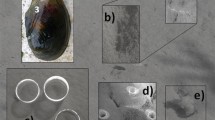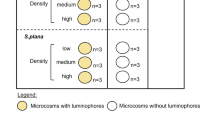Abstract
A 4-week laboratory experiment investigated the behaviour (survival and bioirrigation) and impact of the invasive polychaetes Marenzelleria viridis, M. neglecta and M. arctia on sediment-water solutes exchange, porewater chemistry, and Fe and P interactions in high-salinity sandy sediment (HSS) and low-salinity muddy sediment (LSM) from the Baltic Sea. M. viridis showed deep burrowing with efficient bioirrigation (11 L m−2 day−1) and high survival (71%) in HSS, while M. arctia exhibited shallow burrowing with high bioirrigation (12 L m−2 day−1) and survival (88%) in LSM. M. neglecta behaved poorly in both ecological settings (bioirrigation, 5–6 L m−2 day−1; survival, 21–44%). The deep M. viridis bioirrigation enhanced total microbial CO2 (TCO2) production in HSS by 175% with a net efflux of NH4+ and PO43−, at rates 3- to 27-fold higher than for the other species. Although the shallow and intense bioirrigation of M. arctia in LSM stimulated microbial TCO2 production to some extent (61% enhancement), the nutrient fluxes close to zero indicate that it effectively prevented the P release. Porewater Fe:PO43− ratios revealed that the oxidizing effect of M. arctia bioirrigation increased the PO43− adsorption capacity of LSM twofold relative to defaunated controls while no buffering of PO43− was detected in M. viridis HSS treatment. Therefore, the different behaviour of the three species in various environments and the sharp contrast between M. viridis and M. arctia effects on C, N and P cycling must be considered carefully when the ecological role of Marenzelleria species in the Baltic Sea is evaluated.





Similar content being viewed by others
References
Aller, R.C., and J.E. Mackin. 1989. Open-incubation, diffusion methods for measuring solute reaction rates in sediments. Journal of Marine Research 47 (2): 411–440. https://doi.org/10.1357/002224089785076262.
Banta, G.T., M. Holmer, M.H. Jensen, and E. Kristensen. 1999. Effects of two polychaete worms, Nereis diversicolor and Arenicola marina, on aerobic and anaerobic decomposition in sandy marine sediment. Marine Ecology Progress Series 19: 189−204.
Berner, R.A. 1980. Early diagenesis, a theoretical approach, 291. New Jersey: Princeton University Press.
Bianchi, T.S., C. Rolff, B. Widbom, and R. Elmgreen. 2002. Phytoplankton pigments in Baltic Sea seston and sediments: Seasonal variability, fluxes and transformations. Estuarine Coastal and Shelf Science 55: 369−383.
Blank, M., R. Bastrop, and K. Jürss. 2006. Stress protein response in two sibling species of Marenzelleria (Polychaeta: Spionidae): Is there an influence of acclimation salinity? Comparative Biochemistry and Physiology, Part B 144: 451−462.
Blank, M., A. Laine, K. Jürss, and R. Bastrop. 2008. Molecular identification key based on PCR/RFLP for three polychaete sibling species of the genus Marenzelleria, and the species current distribution in the Baltic Sea. Helgoland Marine Research 62: 129−141.
Bonaglia, S., M. Bartoli, J.S. Gunnarsson, L. Rahm, C. Raymond, O. Svensson, S. Shakeri Yekta, and V. Brüchert. 2013. Effects of reoxygenation and Marenzelleria spp. bioturbation on Baltic Sea sediment metabolism. Marine Ecology Progress Series 482: 43−55.
Boudreau, B.P. 1997. Diagenetic models and their implementation: Modelling transport reactions in aquatic sediments. New York: Springer. https://doi.org/10.1007/978-3-642-60421-8.
Caballero-Alfonso, A., J. Carstensen, and D.J. Conley. 2015. Biogeochemical and environmental drivers of coastal hypoxia. Journal of Marine Systems 141: 190−199.
Cline, J.D. 1969. Spectrophotometric determination of hydrogen sulfide in natural waters. Limnolology and Oceanography 14: 454–458.
Conley, D.J., S. Bjorck, E. Bonsdorff, J. Carstensen, G. Deustoni, B.G. Gustafsson, S. Hietanen, M. Kortekaas, H. Kuosa, H.D. Markus Mier, B. Müller-Karulis, K. Nordberg, A. Norkko, G. Nürnberg, H. Pitkänen, N.N. Rabalais, R. Rosenberg, O.P. Savchuk, C.L. Slomp, M. Voss, F. Wulff, and L. Zillén. 2009. Hypoxia-related processes in the Baltic Sea. Environmental Science & Technology 43: 3412−3420.
Conley, D.J., J. Carstensen, J. Aigars, P. Axe, E. Bonsdorff, T. Eremina, B.M. Haahti, C. Humborg, P. Jonsson, J. Kotta, C. Lannegren, U. Larsson, A. Maximov, M.R. Medina, E. Lysiak-Pastuszak, N. Remeikaite-Nikiene, J. Walve, S. Wilhelms, and L. Zillen. 2011. Hypoxia is increasing in the coastal zone of the Baltic Sea. Environmental Science & Technology 45 (16): 6777–6783. https://doi.org/10.1021/es201212r.
Delefosse, M., G.T. Banta, P. Canal-Vergés, G. Penha-Lopes, C.O. Quintana, T. Valdemarsen, and E. Kristensen. 2012. Macrobenthic community response to the Marenzelleria viridis (Polychaeta) invasion in a Danish estuary. Marine Ecology Progress Series 461: 83−94.
Dell’Anno, A., M.L. Mei, A. Pusceddu, and R. Danovaro. 2002. Assessing the trophic state and eutrophication of coastal marine systems: A new approach based on the biochemical composition of the sediment organic matter. Marine Pollution Bulletin 44: 611−622.
Duarte, C.M., D.J. Conley, J. Carstensen, and M. Sánchez-Camacho. 2009. Return to Neverland: Shifting baselines affect eutrophication restoration targets. Estuaries and Coasts 32 (1): 29–36. https://doi.org/10.1007/s12237-008-9111-2.
Ekeroth, E., S. Blomqvist, and P.O.J. Hall. 2016. Nutrient fluxes from reduced Baltic Sea sediment: Effects of oxygenation and macrobenthos. Marine Ecology Progress Series 544: 77−92.
Forster, S., A. Khalili, and J. Kitlar. 2003. Variations in nonlocal irrigation in a subtidal benthic community. Journal of Marine Research 61 (3): 335–357. https://doi.org/10.1357/002224003322201223.
Gunnars, A., and S. Blomqvist. 1997. Phosphate exchange across the sediment-water interface when shifting from anoxic to oxic conditions—An experimental comparison of freshwater and brackish-marine systems. Biogeochemistry 37 (3): 203–226. https://doi.org/10.1023/A:1005744610602.
Hall, P.O.J., and R.C. Aller. 1992. Rapid, small-volume, flow injection analysis for ∑CO2 and NH4 + in marine and freshwaters. Limnology and Oceanography 37 (5): 1113–1119. https://doi.org/10.4319/lo.1992.37.5.1113.
Hedman, J.E., J.S. Gunnarsson, G. Samuelsson, and F. Gilbert. 2011. Particle reworking and solute transport by the sediment-living polychaetes Marenzelleria neglecta and Hediste diversicolor. Journal of Experimental Marine Biology and Ecology 407: 294−301.
Hietanen, S., A.O. Laine, and K. Lukkari. 2007. The complex effects of the invasive polychaete Marenzelleria spp. on benthic nutrient dynamics. Journal of Experimental Marine Biology and Ecology 352: 89−102.
Jørgensen, L.L., T.H. Pearson, N.A. Anisimova, B. Gulliksen, S. Dahle, S.G. Denisenko, and G.G. Matishov. 1999. Environmental influences on benthic fauna associations of the Kara Sea (Arctic Russia). Polar Biology 22: 395–416.
Jovanovic, Z., M. Larsen, C.O. Quintana, E. Kristensen, and R.N. Glud. 2014. Oxygen dynamics and porewater transport in sediments inhabited by the invasive polychaete Marenzelleria viridis. Marine Ecology Progress Series 504: 181−192.
Karlsson, O.M., P.O. Jonsson, D. Lindgren, J.M. Malmaeus, and A. Stehn. 2010. Indications of recovery from hypoxia in the inner Stockholm archipelago. Ambio 39 (7): 486–495. https://doi.org/10.1007/s13280-010-0079-3.
Kauppi, L., A. Norkko, and J. Norkko. 2015. Large-scale species invasion into a low diversity system: Spatial and temporal distribution of the invasive polychaetes Marenzelleria spp. in the Baltic Sea. Biological Invasions 17: 2055−2074.
Koroleff, K. 1983. Determination of phosphorus. In Methods of seawater analysis, ed. K. Grasshoff, M. Erhardt, and K. Kremling, 2nd ed. Weinheim: Verlag Chemie.
Kristensen, E. 2000. Organic matter diagenesis at the oxic/anoxic interface in coastal marine sediments with emphasis on the role of burrowing animals. Hydrobiologia 426 (1): 1–24. https://doi.org/10.1023/A:1003980226194.
Kristensen, E., and K. Hansen. 1999. Transport of carbon dioxide and ammonium in bioturbated (Nereis diversicolor) coastal, marine sediments. Biogeochemistry 45 (2): 147–168. https://doi.org/10.1007/BF01106779.
Kristensen, E., and M. Holmer. 2001. Decomposition of plant materials in marine sediment exposed to different electron acceptors (O2, NO3 −, and SO4 2−), with emphasis on substrate origin, degradation kinetics, and the role of bioturbation. Geochimica et Cosmochimica Acta 65: 419−433.
Kristensen, E., T. Hansen, M. Delefosse, G.T. Banta, and C.O. Quintana. 2011. Contrasting effects of the polychaetes Marenzelleria viridis and Nereis diversicolor on the benthic metabolism and solute transport in sandy coastal sediment. Marine Ecology Progress Series 425: 125−139.
Li, Y., and S. Gregory. 1974. Diffusion of ions in sea water and deep-sea sediments. Geochimica et Cosmoschimica Acta 38: 703–718.
Lovley, D.R., and E.J.P. Phillips. 1987. Rapid assay for microbially reducible ferric iron in aquatic sediments. Applied and Environmental Microbiology 53 (7): 1536–1540.
Martin, W.R., and G.T. Banta. 1992. The measurement of sediment irrigation rates: A comparison of the Br− tracer and 222Rn/226Ra disequilibrium techniques. Journal of Marine Research 50: 125−154.
Meysman, F., O. Galaktionov, and J.J. Middelburg. 2005. Irrigation in permeable sediments induced by burrow ventilation: A case study of Arenicola marina. Marine Ecology Progress Series 303: 194–212.
Norkko, J., D.C. Reed, K. Timmermann, A. Norkko, B.F. Gustafsson, E. Bonsdorff, C.P. Slomp, J. Carstensen, and D.J. Conley. 2012. A welcome can of worms? Hypoxia mitigation by an invasive species. Global Change Biology 18: 422−434.
Olenin, S., and E. Leppäkoski. 1999. Non-native animals in the Baltic Sea: Alteration of benthic habitats in coastal inlets and lagoons. Hydrobiologia 393: 233–243. https://doi.org/10.1023/A:1003511003766.
Quintana, C.O., T. Hansen, M. Delefosse, G.T. Banta, and E. Kristensen. 2011. Burrow ventilation and associated porewater irrigation by the polychaete Marenzelleria viridis. Journal of Experimental Marine Biology and Ecology 397 (2): 179–187. https://doi.org/10.1016/j.jembe.2010.12.006.
Quintana, C.O., E. Kristensen, and T. Valdemarsen. 2013. Impact of the invasive polychaete Marenzelleria viridis on the biogeochemistry of sandy marine sediments. Biogeochemistry 115 (1-3): 95–109. https://doi.org/10.1007/s10533-012-9820-2.
Renz, J.R., and S. Forster. 2013. Are similar worms different? A comparative tracer study on bioturbation in the three sibling species Marenzelleria arctia, M. viridis, and M. neglecta from the Baltic Sea. Limnology and Oceanography 58: 2046−2058.
Renz, J.R., and S. Forster. 2014. Effects of bioirrigation by three sibling species of Marenzelleria spp. on solute fluxes and porewater nutrient profiles. Marine Ecology Progress Series 505: 145–159. https://doi.org/10.3354/meps10756.
Schiedek, D. 1997. Marenzelleria viridis (Verrill, 1873) (Polychaeta), a new benthic species within European coastal waters. Some metabolic features. Journal of Experimental Marine Biology and Ecology 211 (1): 85–101. https://doi.org/10.1016/S0022-0981(96)02714-1.
Stookey, L.L. 1970. Ferrozine—a new spectrophotometric reagent for iron. Analytical Chemistry 42 (7): 779–781. https://doi.org/10.1021/ac60289a016.
Sundby, B., C. Gobeil, N. Silverberg, and A. Mucci. 1992. The phosphorus cycle in marine sediments. Limnology and Oceanography 37 (6): 1129–1145. https://doi.org/10.4319/lo.1992.37.6.1129.
Tang, M., and E. Kristensen. 2007. Impact of microphytobenthos and macroinfauna on temporal variation of benthic metabolism in shallow coastal sediments. Journal of Experimental Marine Biology and Ecology 349 (1): 99–112.
Urban-Malinga, B., J. Warzocha, and M. Zalewski. 2013. Effects of the invasive polychaete Marenzelleria spp. on benthic processes and meiobenthos of a species-poor brackish system. Journal of Sea Research 80: 25−34.
Valdemarsen, T., C.O. Quintana, M.R. Flindt, and E. Kristensen. 2015. Organic N and P in eutrophic fjord sediments—Rates of mineralization and consequences for internal nutrient loading. Biogeosciences 12: 1765−1779.
Viitasalo-Frösén, S., A.O. Laine, and M. Lehtiniemi. 2009. Habitat modification mediated by motile surface stirrers versus semi-motile burrowers: Potential for a positive feedback mechanism in a eutrophied system. Marine Ecology Progress Series 376: 21−32.
Viktorsson, L., N. Ekeroth, M. Nilsson, M. Kononets, and P.O.J. Hall. 2013. Phosphorus recycling in sediments of the central Baltic Sea. Biogeosciences 10 (6): 3901–3916. https://doi.org/10.5194/bg-10-3901-2013.
Zettler, M.L., D. Schiedek, and B. Bobertz. 2007. Benthic diversity indices versus salinity gradient in the southern Baltic Sea. Marine Pollution Bulletin 55: 258−270.
Acknowledgments
We are thankful to Alf Norkko and Joanna Norkko for organizing a workshop on the state-of-art Marenzelleria research in 2011 at Tvärminne Station, Finland, which provided collaborations and valuable discussions with other scientists. We thank Ralf Bastrop for sampling M. neglecta worms in Germany and transporting them safely to Denmark.
Funding
The work was funded by the Sao Paulo Research Support Foundation (FAPESP, no. 2012/06121-1) to COQ, by the Danish Council for Independent Research (contract no. 12-127012) to EK and by the Swedish Agency for Marine and Water Management (grant no. 202100-3062) to JG and CR. FN was funded by Formas Mobility Grant (no. 2013-1322).
Author information
Authors and Affiliations
Corresponding author
Additional information
Communicated by Patricia Ramey-Balci
Rights and permissions
About this article
Cite this article
Quintana, C.O., Raymond, C., Nascimento, F.J.A. et al. Functional Performance of Three Invasive Marenzelleria Species Under Contrasting Ecological Conditions Within the Baltic Sea. Estuaries and Coasts 41, 1766–1781 (2018). https://doi.org/10.1007/s12237-018-0376-9
Received:
Revised:
Accepted:
Published:
Issue Date:
DOI: https://doi.org/10.1007/s12237-018-0376-9




